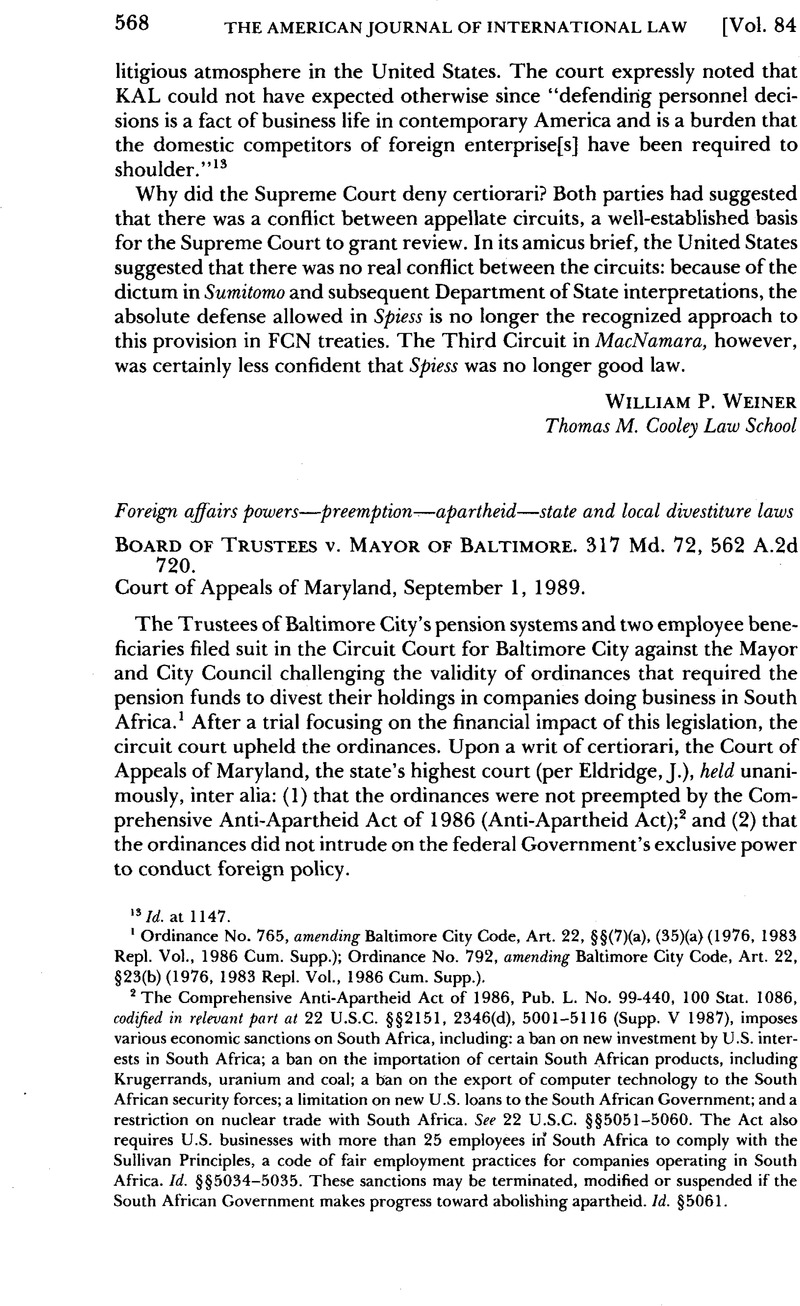No CrossRef data available.
Published online by Cambridge University Press: 27 February 2017

1 Ordinance No. 765, amending Baltimore City Code, Art. 22, §§(7)(a), (35)(a) (1976, 1983 Repl. Vol., 1986 Cum. Supp.); Ordinance No. 792, amending Baltimore City Code, Art. 22, §23(b) (1976, 1983 Repl. Vol., 1986 Cum. Supp.).
2 The Comprehensive Anti–Apartheid Act of 1986, Pub. L. No. 99–440, 100 Stat. 1086, codified in relevant part at 22 U.S.C. §§2151, 2346(d), 5001–5116 (Supp. V 1987), imposes various economic sanctions on South Africa, including: a ban on new investment by U.S. interests in South Africa; a ban on the importation of certain South African products, including Krugerrands, uranium and coal; a ban on the export of computer technology to the South African security forces; a limitation on new U.S. loans to the South African Government; and a restriction on nuclear trade with South Africa. See 22 U.S.C. §§5051–5060. The Act also requires U.S. businesses with more than 25 employees in South Africa to comply with the Sullivan Principles, a code of fair employment practices for companies operating in South Africa. Id. §§5034–5035. These sanctions may be terminated, modified or suspended if the South African Government makes progress toward abolishing apartheid. Id. §5061.
3 Section l(ii) of Ordinance No. 765, supra note 1, states that such companies shall be identified by reference to the most recent annual report of the Africa Fund entitled “Unified List of United States Companies with Investments or Loans in South Africa and Namibia.” The court held that this was not an impermissible delegation of legislative authority to a private entity because, even though the list is subject to revision, the pension fund Trustees are free to reject the findings of the Africa Fund regarding any particular company. 561 A.2d 720, 732.
4 In addition to the two beneficiaries that joined in the lawsuit, four others were allowed by the court of appeals to intervene.
5 The Trustees advanced numerous other constitutional arguments as well, each of which the court of appeals ultimately rejected. The court held that the ordinances did not unconstitutionally impair the obligations of the City’s pension contracts with pension beneficiaries; did not constitute a taking without just compensation in violation of the Fifth and Fourteenth Amendments; and did not violate the Commerce Clause.
6 See Pennsylvania v. Nelson, 350 U.S. 497, 504 (1956) (quoting Rice v. Santa Fe Elevator Corp., 331 U.S. 218, 230 (1947)).
7 562 A. 2d at 741.
8 The only concrete evidence the court of appeals could identify was a claim by Senator Lugar that the Anti-Apartheid Act preempted local legislation. The court balanced this against the view of Senator Kennedy, the legislation’s coauthor, who strongly insisted that it was to have no preemptive effect. Id. at 742–43 n.47.
9 22 U.S.C. §5116 (Supp. V 1987).
10 562 A.2d at 742 (citing Tribe, Memorandum on the Nonpreemptive Effect of the Comprehensive Anti–Apartheid Act of 1986 Upon State and Local Measures, 132 Cong. Rec. S 12,534, 12,535 (daily ed. Sept. 15, 1986)).
11 Id. at 743 (quoting H.R. Res. 549, 99th Cong., 2d Sess., 132 Cong. Rec. H6758 (daily ed. Sept. 12, 1986)). The court of appeals recognized that the resolution merely expressed the sense of the House and therefore lacks the force of law. However, it noted that the House leadership had anticipated a presidential veto and had put the Anti-Apartheid Act on an expedited schedule. The bill was not sent to a conference committee and members were not permitted to offer amendments. Under these circumstances, the House sponsors of the Act drafted the resolution to express the House’s view on the preemption issue.
12 Specifically, the Trustees pointed out that the ordinances contain no provision for termination or modification of divestiture in the event progress is made, whereas the Anti-Apartheid Act provides that the President may suspend or modify its sanctions under certain conditions. Appellants’ Brief at 46.
13 562 A.2d at 743.
14 389 U.S. 429(1968).
15 331 U.S. 503 (1947). The California statute at issue in Clark allowed a nonresident alien to inherit personal property only if, under the laws of the alien’s nation, U.S. citizens had a reciprocal right to inherit personal property on the same terms and conditions as the alien’s fellow citizens. In Zschernig, the Court struck down a similar Oregon law on the ground that the history and operation of the statute established that it was “an intrusion by the State into the field of foreign affairs.” Zschernig, 389 U.S. at 432.
16 389 U.S. at 435.
17 562 A.2d at 746 (quoting the circuit court).
The court of appeals cited for support the opinion of Maryland’s Attorney General that Code (1985), §6–208 of the State Finance and Procurement Article, generally prohibiting the deposit of state funds in financial institutions with loans to the South African Government, “does not call for the level of state intrusion found repugnant in Zschernig.” 69 Op. Att’y Gen. Md. 87, 90 (1984).
18 562 A.2d at 746.
19 Id. at 747 (quoting Note, State and Municipal Governments React Against South African Apartheid: An Assessment of the Constitutionality of the Divestment Campaign, 54 U. Cinn. L. Rev. 543, 574(1985)).
20 115 111. 2d 221, 503 N.E.2d 300 (1986).
21 41 N.Y.2d 345, 353, 393 N.Y.S.2d 312, 318, 361 N.E.2d 963 (1977).
22 562 A.2d at 747 (quoting 41 N.Y.2d at 352, 393 N.Y.S.2d at 317, 361 N.E.2d at 968).
23 495 F. Supp. 1365 (D.N.M. 1980).
24 Pensions & Investment Age, Nov. 13, 1989, at 32.
25 58 U.S.L.W. 3457 (U.S. Jan. 16, 1990) (No. 89–889).
26 58 U.S.L.W. 3522 (U.S. Feb. 20, 1990) (No. 89–889).